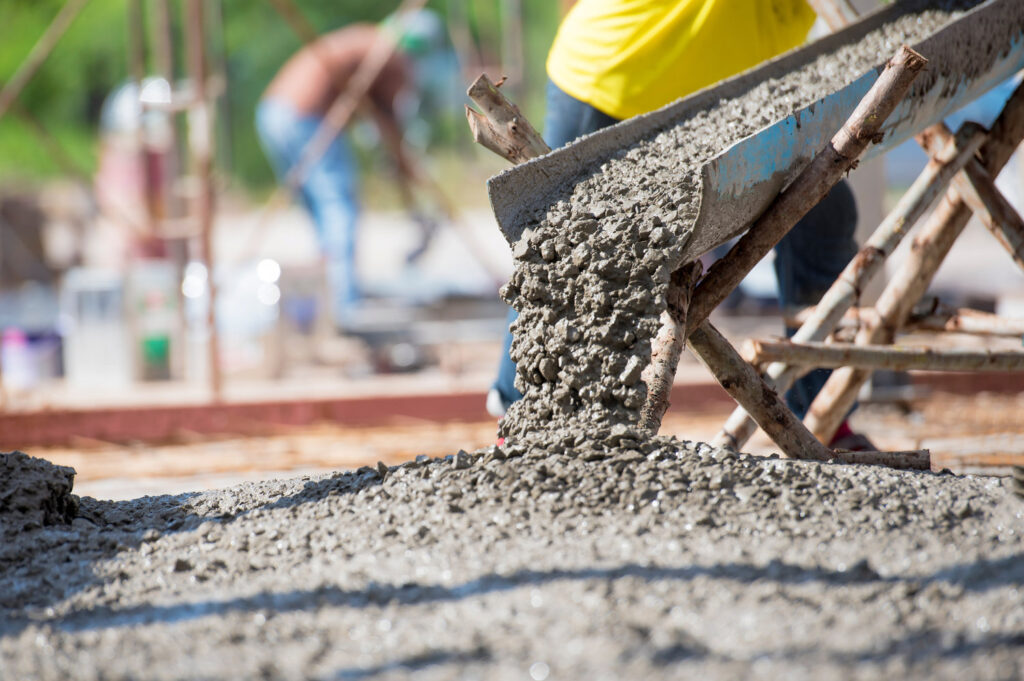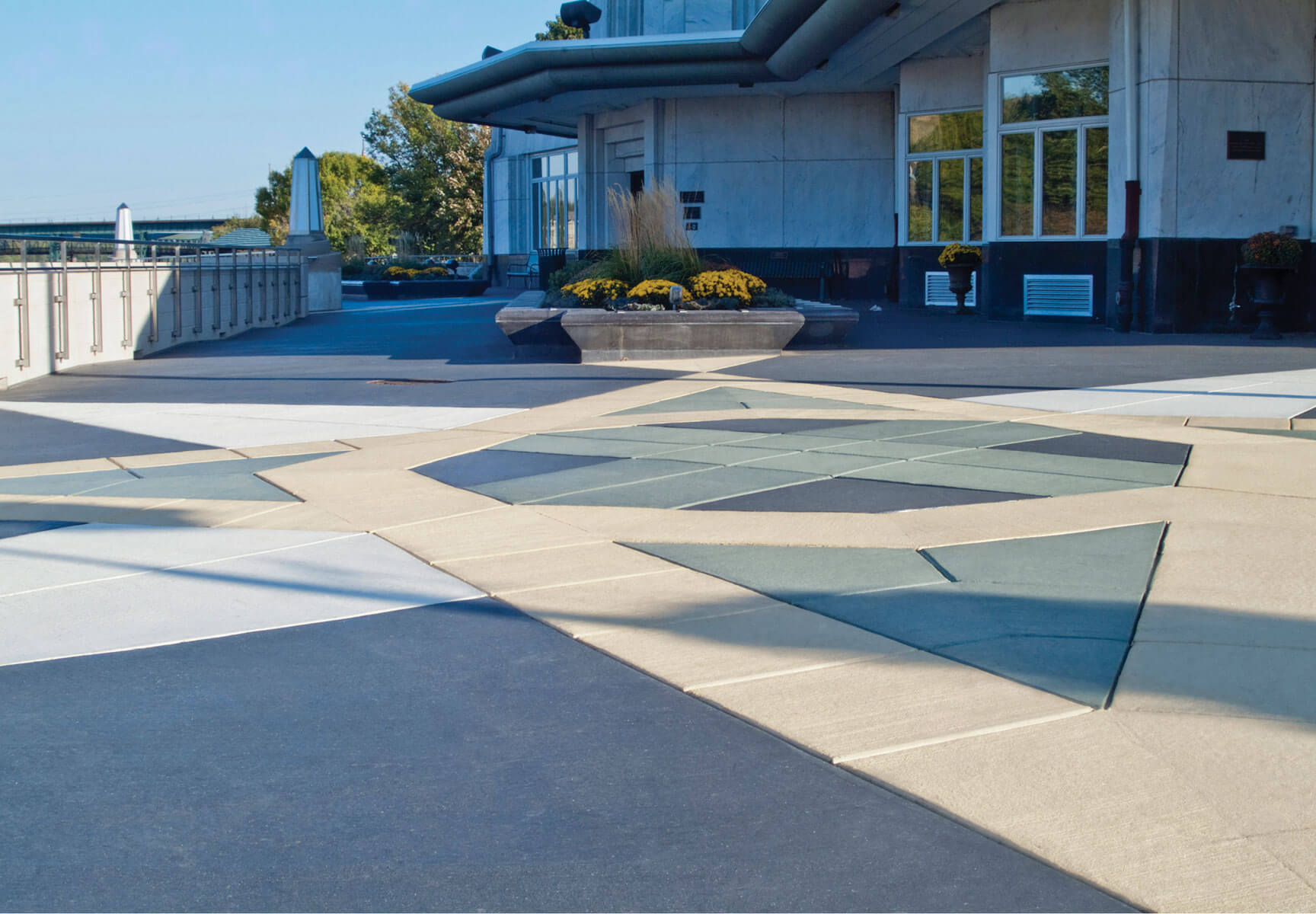If the monotony of drab, grey concrete is taking away from the aesthetic appeal of your house, we’ve got a solution!
There’s nothing a splash of colour can’t fix! Use your imagination and creativity to spruce up that old concrete slab on the patio or driveway.
Concrete colouring is the latest hype in modern architecture. Even though it has been around for ages, there has been a recent surge in its popularity.
And that’s mostly because of the introduction of newer methods and an ever-broadening spectrum of hues. But that also makes it a tad confusing for homeowners who aren’t familiar with this concept.
To make things easier, we’ve compiled this guide to tell you all about the different colouring options and how to decide what’s best for your project.
Now, without any further delay, let’s dive right into it.
Ways Of Colouring Concrete
There are five popular ways of painting concrete. In this section, we’ve explained each of these processes, along with their benefits and drawbacks.


1. Integral Colouring
One of the most widely used methods of tinting freshly placed slab is through integral colouring. In this process, an iron oxide pigment is blended with concrete that infuses it with a fade-resistant, vibrant hue. The pigment diffuses effortlessly into newly made concrete, mixing well enough to look like a part of the blend.
They are available in granular and liquid form and offer customisable colour options. What adds to its appeal is that it closely replicates natural stones and offers subtle, earthy tones.
The pigment is mixed with concrete in a ready-mix truck and water is carefully balanced in the admixture to ensure consistent colouring.
Integral colouring has a wide range of applications, both on interior and exterior surfaces. Pool decks, sidewalks, driveways and other heavy-traffic zones benefit from this method, as do several residential and commercial buildings. They are UV-resistant and chemically balanced enough not to fade away with time.
The primary advantage of integral colouring is that the colour blends into the entire concrete mixture and gives it a uniform hue throughout. So, even if the surface chips or cracks, the colour remains unhampered.
Adding to its long list of advantages is the fact that it saves labour costs. Mixing colours requires less time and effort compared to some other concrete colouring options. It is best to do the work on the job site and a consistent water-to-cement ratio is crucial to ensure uniform tinting.
The only downside of integral colouring is that it’s slightly expensive compared to other alternatives.
2. Acid Stains
Staining is one of the most popular methods of colouring concrete. The acid is formulated with water, acid and mineral salts. This chemical mix reacts with the minerals, particularly calcium hydroxide, present in the concrete and therefore, etches the surface.
The colour options are limited to blue-greens, tans and other earthly tones but it is possible to create a layered and artistic effect. In fact, combining two different colours of acid stains can produce a variegated pattern. To do this, cover the entire concrete with one colour and then use a sponge to stain spots with different tints.
To make the spot-staining visible, we use lighter hues as the base and then use darker hues for veining. To make the colour lighter, you can dilute the acid stain using stain extenders and establish the base. You can also achieve a variegated effect by building upon this light base.
Often patios, walkways and indoor floors are acid stained. It is an excellent choice for outdoor surfaces since it makes them UV-resistantand not susceptible to wear and tear. It’s easy to create textures but there’s a limit to the number of layers you can build. Aesthetically, the colours all blend and strike each other out.
Not just that, it’s also not chemically viable since every layer of acid reacts with the lime on the surface. Once the lime dries out, so does the ability of the surface to absorb more staining.
Contractors undergo special training to learn the intricacies of layering. However, there are certain safety precautions that a contractor should take while using this method. Protective masks, gloves and eye protection are essential since acid is corrosive and can cause long-term damage.
Lastly, after application, you must thoroughly wipe the surface to neutralise the acid and remove residual stains.
3. Water-Based Stain
Next up, we have water-based stains, which come with endless colour options. It’s time to move away from the subtlety of earthy tones with a full spectrum of customisable colour options. With water-based stains, you get to jazz up the concrete on your indoor and outdoor surfaces with dramatic and bold shades.
This type of stain has polymers and pigments blending with water to produce different tones. The opaque stain seeps into the surface and produces a permanent colour. In addition to this, you get more control over the shades.
Besides no chemical reaction takes place, making it a safe method. What makes them stand out is they are eco-friendly. Since water-based stains have low VOCs, they become much safer than their acid counterparts. Plus, their application does not produce any toxic odour or fumes and you can use a roller, brush or a sponge, taking no safety precautions.
Also, their efficiency remains uncompromised and they’re UV-resistant too.
They leave behind a vibrant and translucent look that is fade-resistant. After staining, the surface doesn’t need scrubbing to neutralise the stain or remove residual stains. This makes it a labour-saving process and more than one layer of colour can be applied depending on the requirement.
Lastly, you must apply a reliable topcoat to preserve the lustre and the surface must be porous enough to absorb the water stain.
4. Concrete Dyes
With their unlimited range of colour options, dyes are another popular option for concrete colouring. Unlike acid stains, dyes remain nonreactive and are available in two forms: water-based and solvent-based. Out of the two types, water-based dyes produce a marble-like effect, whereas solvent-based dyes give a more even colouring.
The water-based variant is also more eco-friendly because of the low level of toxic chemicals in its composition. However, the colours produced are more subtle and it fails to hide the flaws in the concrete. Solvent-based dyes offer more expansive coverage and provide darker tints but they produce toxic fumes and are highly flammable.
Dyes contain finely ground translucent particles that penetrate the concrete to give it a uniform hue. In contrast to acid stains, where the colour patterns are unpredictable, you can easily control the colouring of concrete through dyes and get a much more predictable tint.
Moving forward, dyes can add a pop of colour and drama to your indoor and outdoor surfaces. If you’re looking for bold hues like red, purple, orange, blue and various other shades that you can mix to make new tinctures – this is the way to go.
However, not all dyes are UV-resistant, so the hue might fade if you use them for outdoor surfaces.
What makes them as durable as staining are their small particles which penetrate the concrete, filling their pores. After application, seal the dyed surface with a topical sealer. Ordinarily, several wax coats are applied since they act as a shock-absorbent, preventing the surface from scuffs and grime.
Perhaps the only downside is that dyed surfaces require proper maintenance, and solvent-based dyes are highly flammable. So take adequate safety precautions and be careful while working with them.
5. Colour Hardeners
Colour hardeners come in powdered form and are tossed into newly placed concrete. A wood bull float or trowel then works the finely grounded particles into the top layer of the surface. The hardeners have a combination of fine pigments, silica sand, portland cement and wetting agents.
The water that bleeds from freshly placed concrete blends with the powdered particles, diluting it and causing it to integrate into the surface. Furthermore, the colour is more concentrated and richer. You get varied tints, including gorgeous shades of green and blue.
The mineral aggregates and cement present in the mix also add to the density of the surface. Thus, this method will give you a concrete surface that is more durable and resistant to fading and moisture.
Since they are UV-resistant and add strength and density to the slab, we can use them for exterior and interior surfaces, especially for stamped concrete and concrete overlays.
They can withstand heavy foot traffic and make the surface impervious, preventing it from trapping moisture and stains.
The only downside to this method is that it is labour-intensive and relatively difficult to apply compared to integral colouring. Also, since they are solely concentrated on the topmost layer, grinding can erode the tint.
Since some powdered particles might splash onto adjacent buildings or slabs, it is imperative to cover them with plastic sheeting. Although they are more affordable compared to integral colouring, the cost of labour is relatively high. So it might not prove to be an economical choice.
Finally, remember to wear protective gear while working with colour hardeners since air-borne particles can be detrimental to health.
Benefits of Concrete Colouring
Concrete colouring might not look like a necessity, but there are many reasons why it is popular in modern architecture.


1. Versatile
It is possible to achieve a variety of designs and finishes by painting concrete. Acid staining, in particular, gives a very understated charm to the structure because of its ability to layer effortlessly. For more vibrant tones, you’ve got water-based stains. You can get variegated textures and colours, which is a far cry from the monotony of plain concrete.
2. Wide Range Of Applications
Concrete colouring is not just limited to interior surfaces. You can use them in the garage, driveways, patios and sidewalks. Since most of the options are UV-resistant, they are unlikely to fade away when exposed to sun and rain. Thus, they not only take care of the stylistic facets of any project but are also weatherproof and long-lasting.
3. Durable
Apart from being attractive, concrete painting is highly durable. There is no doubt that concrete is a reliable material but colour hardeners, for example, will enhance its strength and add to its density.
With colouring, you can combine the functionality of concrete with the vibrancy of tints for attractive indoor and outdoor surfaces.
How To Choose The Best Method For Your Project?
Now that we’ve explained each of the concrete colouring methods, it is time to talk about which method best suits your project.
For a new project, any of the processes mentioned in this guide will work just fine. Some methods, like integral colouring and colour hardening, can work only on freshly placed concrete. However, if it is a restoration project, then acid stains and water-based dyes are recommended.
If you’re on the lookout for customisable and uniform colouring, then water-based stains are your best bet. If you’re looking for darker tints, then opt for solvent-based dyes.
For a mottled look, we’d recommend acid stains. Colour hardeners can be great for smaller projects.
Final Words
With that, we come to the end of our detailed guide and we hope it has given you enough insight into the world of painting concrete.
Concrete as an industrial product is unrivalled in terms of durability and efficiency. So, to add vibrancy to it would be the icing on the cake. The world of decorating concrete is just being explored and there are limitless possibilities in it.
Apart from the design choices that these tinting options bring with them, they also lend strength to the material and improve its structural integrity.
Before we go, here’s a reminder: concrete is one giant blank canvas, and you can splash all the colours you want on it. So, go ahead and explore all the options out there.
Do reach out to us in the comments below if you still have any queries.
Until next time, happy concrete colouring!
Published Date : March, 29 2021


